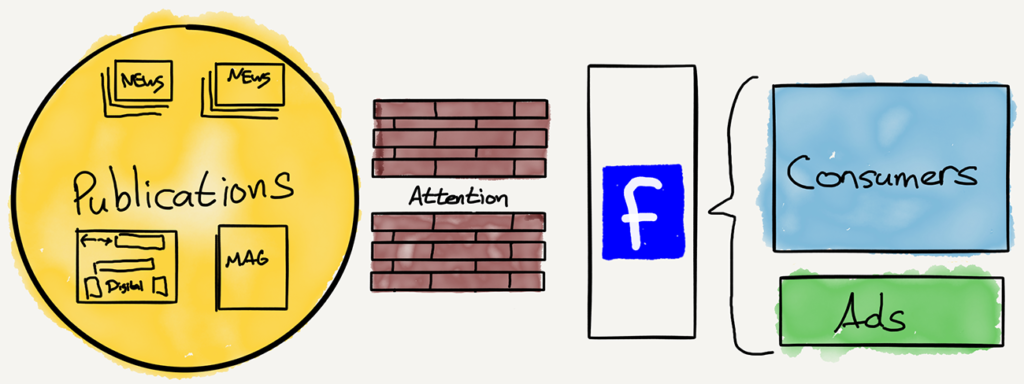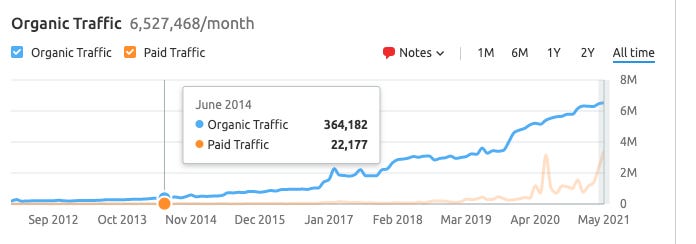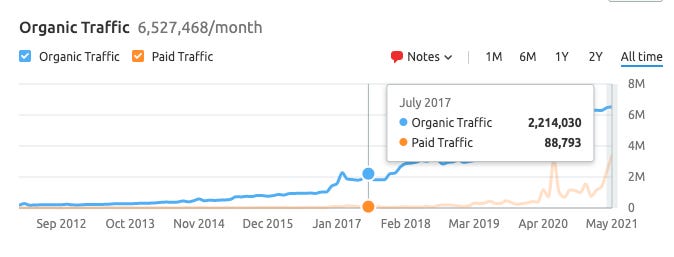Marketing-Led Growth with Outbound Fury
Product-Led Growth is all the rave. But the real focus needs to be on marketing-led growth.
[There’s a lot I’ve learned, created, and challenged over the years while working for some of the largest tech brands in the world. This newsletter is my place to share these stories and lessons with you in hopes that it inspires you to take your marketing to the next level.]
Anyone that’s ever worked with me has heard me repeat the phrase “Outbound Fury” ad nauseum. Many of those same people have also asked me: “What does that even mean?”
Here is a complete breakdown of my signature rallying cry.
Introduction to Outbound Fury
It all started when I was at early-stage Google, and we decided to go to war with then industry Goliath, Microsoft. The year was 2011 (hard to believe that was almost 10 years ago). I was a new PMM in the Google Enterprise Marketing team. Google Apps was raging a battle with Microsoft Office. We were native to the cloud and Microsoft was just cobbling together a cloud solution; it was the first chapter of the cloud wars.
Even though our team was on the frontlines, Google's executive leadership team was not keen on spending millions of dollars on a Google Apps brand campaign. The attention then was on Google+ — their answer to Facebook. So we were armed with our wits and creativity to answer the question: How do we raise awareness for a product in a new category without brand $$s?
The answer:Lots of content! Lots of controversial content!
The Google Enterprise team was eager to compete with Microsoft. Microsoft was the incumbent and Google was the challenger, so any association with Microsoft was a win. We narrowed in on our main KPI — any press article written about “Microsoft Office” should mention “Google Apps” as the opponent and category disruptor.
Every week the team met early Monday to brainstorm ideas. Nothing was off the table. Product certainly helped with a lot of the “outbound fury” momentum: Google Apps was shipping a feature a day. But our team definitely contributed some out-of-the-box, controversial ideas. For example, the time the team decided to rain on Microsoft’s parade and write a blog post called “365 reasons to consider Google Apps” 😂 a day before the launch of Office 365, and the press devoured it.
In the time-honored tech tradition of raining on a competitor's parade, the Google Apps team attacked Office 365 in a blog post the day before Microsoft launched its cloud offering. The post, "365 reasons to consider Google Apps," went up on the Official Google Enterprise Blog on Monday. The post, written by Shan Sinha, Google Apps product manager, actually boiled down to four arguments:
- "Office 365 is for individuals. Apps is for teams."
- "Office 365 is built for Microsoft. Apps is built for choice."
- "Office 365 is 11 different plans, three editions and two tiers. Apps is $5/month with no commitment."
- "Office 365 is about the desktop. Apps is about the web."
Microsoft pulled no punches. But the strategy worked. Microsoft had more to lose as an incumbent. And the more Microsoft engaged, the more it created free press for us (and the media loved the cloud wars).
But one caveat to all of this: The product has to back you up. Google Apps being cloud-native was superior to Office 365. We were eating Microsoft’s l(a)unch.
What is Outbound Fury?
The literal definition is being furious in your outbound motion. 😆 It’s the concept of having a consistent presence in the media (with various forms of content) using tactics like viral tweets, controversial blog posts, informational customer stories, product momentum news, funny videos, PR thought leadership, etc. Imagine anything you can do as a marketer to garner the attention of your prospective customers and build a brand guerilla-style.
Let me give some examples. During my Bitbucket days, Github was our primary competitor. Zach Holman, one of the well-known Github engineers, tweeted the following (which was a joke):
So in order to have some fun, we tweeted back:
As you can see it garnered a lot of attention in the Twitterverse and especially among the developer community.
Another good example is an easter egg we planted in the command line of Bitbucket. When you did a remote push on St. Patrick’s Day, a shamrock would pop up:
The whole idea for that pot of gold in the line of code was planned while having beers with an engineer. It caused a real stir among the developer community and got hundreds of tweets and retweets.
These two were not isolated incidents, here are some more examples:
We wrote a post called Bitbucket: 2014 in review and it was on the front page of Hacker News for a day.
We started a social media campaign called #BuiltwithBitbucket to encourage our developers to share the apps they were building with Bitbucket and it took its own life on Twitter.
We celebrated 10 years of Git anniversary with a powerful infographic which was picked up by linux.com.
We sent a cake to Github when they lost to us on a karaoke challenge. Proof of that night here.
No comments! 😎
You get the idea - there were nothing newsworthy about them. We just made news out of thin air and had a constant presence online among the dev community. 🎉
The Origins of Outbound Fury
In order to understand the genesis of Outbound Fury, you have to start with the media world and how it has changed over the internet era.
The Old Media Model
The primary medium to reach a broader audience in the late 1900s was through TV, radio, newspapers, and magazines. There was no concept of organic content. You were at the mercy of the publication editors. Many Fortune 500 companies hired PR firms that had a Rolodex of contacts. The other option was to pay a hefty sum to advertise on these mediums. Imagine if you were an upcoming business, you had no chance against the giant incumbents.
Here’s how Ben Thompson describes the old media model in “The great unbundling”:
Nearly all media in the pre-Internet era functioned under the same general model:
Note that there are two parts in this model when it comes to making money — distribution and then integration — and the order matters. Distribution required massive up-front investment, whether that be printing presses, radio airplay and physical media, or broadcast licenses and cable wires; the payoff was that those that owned distribution could create money-making integrations:
Print: Newspapers and magazines primarily made money by integrating editorial and advertisements into a single publication.
Music: Record labels primarily made money by integrating back catalogs with new acts (which over time became part of the back catalog in their own right).
TV: Broadcast TV functioned similarly to print; control of distribution (via broadcast licenses) made it possible to integrate programming and advertising.
The New Media Model
And then the internet happened. And it completely flipped the model on its head.
A consistent theme on Stratechery is that perhaps the most important consequence of the Internet, at least from a business perspective, was the reduction of the cost of distribution to effectively zero.
The most obvious casualty has been text-based publications, and the reason should be clear: once newspapers and magazines lost their distribution-based monopoly on customer attention the integration of editorial and advertising fell apart. Advertisers could go directly to end users, first via ad networks and increasingly via Google and Facebook exclusively, while end users could avail themselves of any publication on the planet.
For Google and Facebook, the new integration is users and advertisers, and the new lock-in is attention; it is editorial that has nowhere else to go.
The same thing happened to TV and radio. Consumers could flock to Youtube or Netflix to watch shows and consume content on-demand. The podcast became a thing. Internet democratized radio for creators via apps like Clubhouse. Spotify and Apple completely disrupted the music industry.
Suddenly the old media houses like TV, radio, and newspaper became a relic of the past.
Aggregation Theory and Democratized Distribution
Democratized Distribution happened primarily due to what Ben Thompson calls “Aggregation Theory”. Thompson continues to explain this disruption and how it put the power in the hands of the business owner and its teams (not the media companies):
What is Aggregation Theory?
Aggregation Theory is a completely new way to understand business in the Internet age. Business schools suggest that with the right frameworks, an executive can understand how to manage all kinds of problems: what happens, though, when many of the inputs to those frameworks are zero?
Zero distribution costs. Zero marginal costs. Zero transactions. This is what the Internet enables, and it is completely transforming not just technology companies but companies in every single industry. Old moats are gone — and new ones can be built — and Aggregation Theory helps you identify both.
This completely changed how we do marketing. Thanks to the internet and social media networks, reaching the masses became as easy as creating a web page or posting a video on Youtube. It also created a level playing field for upcoming startups — you could hack your way into brand-building using SEO, content, thought leadership, viral social, etc. You didn’t have to spend millions of dollars on brand — you could literally build your brand on a dime. And that sowed the seed for what I affectionately call, “Outbound Fury”.
Outbound Fury in Action
Case Study 1: Wendy’s
Wendy’s Twitter account has built quite the reputation with humor. And, especially their beef with McDonalds. 🤣

If you are not following Wendy’s Twitter account, you are missing out on all the fun. It is a great example of Outbound Fury. The account is filled with some of the funniest quips which have gone viral (and kept the brand fresh among its customers).
You can find more examples here.
Case Study 2: Intercom
In the early days, Intercom went after product-minded founders who wanted to use their product to communicate with customers right from the website. Later on, in order to scale they went after different personas like marketers. So, how did they go after their target marketing audience? Create content so compelling that we pmms flocked to their website without hesitation or provocation. I myself have circulated many of their posts (for example this one on product launches), which had nothing to do with Intercom. It was a very savvy “outbound fury” way to build their brand.
You can download their book on marketing here.
Case Study 3: (Moar) Bitbucket
Developers hate marketing. So with this predicament, how do you grab the attention of developers? Not by talking about the product, but by creating content which is educational. The folks at Atlassian (before my time) created a “Git microsite” — a website with tips and tutorials on Git.
It was good and relevant content but was not discoverable. So, we poured gasoline on the site by optimizing it for SEO. How?
We prioritized all the Git keywords based on traffic.
For each of those keywords we identified the target page on the Git microsite.
We looked at the old Git-related blogs and webpages which were ranking high on Google. We linked the Git keywords back to the microsite’s relevant pages.
We started a Git newsletter and highlighted the pages which we wanted to rank.
Gave it 30 days. 🙌🏼
The pages started ranking in Google Search for all Git-related keywords. It became one of the largest contributors to Bitbucket signups in the long run.
Now it gets 6M organic visitors per month. Just amazing!
Case Study 4: Trello
The Trello team has done an incredible job (not that I am biased 😆) in publishing amazing content on the Trello blog. Some of their most popular posts are on productivity tips and remote work.
For example, this talk by Lauren Moon was one of the most popular talks at Atlassian Summit (Atlassian’s customer conference) and is based on a very popular blog:
Before remote work was cool, Trello pioneered thought leadership on “remote work.” With the rapid shift to remote work thanks to the pandemic, we ungated one of our most popular remote work eBooks in order to give our audience access to valuable insights, tips, and strategies for managing a remote team. We also translated the content into several languages including Portuguese, German, Spanish, and Japanese. To date, the majority of Trello’s growth comes from SEO, content, and word of mouth.
Add to that some delightful brand campaign videos (and social media quips) which became the hallmark of Trello marketing:
According to SimilarWeb, 87% of trello.com traffic is direct and 8% is organic. Trello has 50M+ registered users 🤯 (official but the actual number is more).
Product-Led Growth and Outbound Fury
You would get the most ROI when you combine Outbound Fury with Product-Led Growth (PLG). A prerequisite is a simple, delightful website where a prospective user can easily try the product.
PLG is all the rave now but no one is talking about Marketing-Led Growth. Outbound Fury had a huge role to play towards the success of well-known SaaS products like Slack, Dropbox, Trello, Confluence, and Intercom.
The mantra for quite some time was, “Build an amazing product and users will come”. This is no more true. You do need to build the house then immediately invite everyone over to the party (even if you haven’t finished painting every wall). SaaS is competitive and your users have limited attention. You need Outbound Fury. My advice to founders and CEOs - invest as much on marketing as you do on product.
“Believe in Outbound Fury, even if it means sacrificing everything.” 📣
[Note: A huge shoutout to Lauren Moon and Janet Mesh (Aimtal) for reviewing the post and providing extensive copy-editing feedback. I also want to thank Arun Mathew, Hiten Shah, Jeff Shiner, Jeannie De Guzman, Julian Teixeira, Akshay Bhargava, and Archana Agarwal for reviewing the early drafts - I am eternally grateful! ]



















Very well written.
Especially like the argument around building content to establish your company as an authority in a space, even if the content is not directly about the company's products.